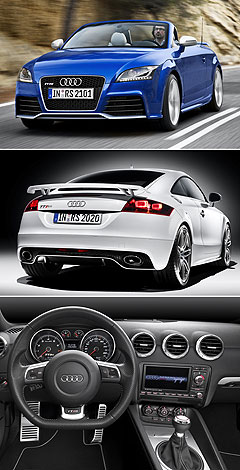Future models - Audi - TT - RSPlenty of RS for the wickedest Audi TTOz bound: The hot Audi TT RS is destined for Australia next year. Audi drops a five-pot turbo screamer into the ultimate TT, the RS10 Mar 2009 THE first turbo-charged five-cylinder Audi since the S2 coupe and S4 sedan of the mid 1990s wowed Geneva show goers last week in the form of the TT RS, brandishing 250kW of power and 450Nm of torque. The good news for Australian buyers is that Audi will import it in both Coupe and Roadster convertible shapes, but the bad news is that the wait will be at least 12 months, possibly more. By contrast, Europeans will see the TT RS from the middle of this year. Perhaps more disappointing for enthusiasts of those ‘proper’ quattro Torsen differential 4WD systems that helped make the Audi Ur-Quattro of 1980s such an epochal sports and competition car is that there isn’t one for the TT RS. Instead, and despite the fact that Audi claims the TT RS has a “quattro all-wheel-drive and a high-performance chassis”, the TT RS will employ a variation of the Haldex clutch system that the Volkswagen Group has adapted for all of its transverse engined models, which redirects torque from the front to the rear wheels as required. The engine is rumoured to be based on a Lamborghini V10, though Audi says it was “created from scratch” for the TT RS. The 2480cc 2.5-litre five-pot petrol engine that uses FSI direct fuel injection as well as a turbo-charger and intercooler to produce 250kW of power and 450Nm of torque between 1600 and 5300rpm. That’s 100.8kW per litre.  Audi says the 1450kg TT RS Coupe’s power to weight ratio is an “outstanding” 4.3kg per brake horsepower, and 4.4kg/bhp in the 1510kg Roadster. Audi says the 1450kg TT RS Coupe’s power to weight ratio is an “outstanding” 4.3kg per brake horsepower, and 4.4kg/bhp in the 1510kg Roadster.It cites the TT’s part aluminium space-frame construction in helping achieve these results, which in turn aid the RS Coupe’s 4.6 second 0-100km/h sprint-time, on the way to a 250km/h electronically-limited maximum. The ragtop takes 0.1 seconds longer. Conversely, the RS is no dipsomaniac either, achieving between 9.2 (Coupe) and 9.5 L/100km (Roadster), Gear changes are actuated via a short-shift six-speed manual transmission that consists of both a high overdrive for improved economy and short-ratioed gears to help the TT RS get along at a cracking pace. The engine is 49cm long and tips the scales at 183kg (a record, says Audi). It is made of ‘vermicular-graphite cast iron’ for optimum strength and low-weight. This is also used in the larger TDI turbo-diesel units for the same reason. Lightweight and high-strength cylinder head, pistons and connecting rods are also employed. Other mechanical details include a 1.2-bar of boost pressure from the lone turbo-charger, 120-bar injection pressures for the common-rail system, a 10.0:1 compression ratio and chain-driven camshafts. True to RS form, the hottest TT features a lower-console mounted Sport button that activates a flap in the left exhaust tailpipe to relieve backpressure and boost responsiveness. The ‘sport chassis’ is 10mm lower than usual, and features firmer springs and revised shock absorbers. It is available with Audi’s magnetic ride adaptive damping system. The wheels are 18-inch alloys shod with 245/45 tyres, while 370mm vented discs at the front and 310mm items in the rear take care of braking. Audi has also retuned the ESC stability control to allow it to be partly or completely neutralised. The TT RS is most easily identified by its large front spoiler, square air intakes, high-gloss black grille ensconced in a matt aluminium frame, and TT RS badges from front-on, new five-spoke alloy wheel designs, matt aluminium mirror casings and a deep side sill in profile, and a different pair of oval exhausts out back. As with all TTs, seating is 2+2 in the Coupe and front-only in the Roadster, while a flat-bottomed steering wheel and a smattering of RS-specific trim has been included, and boost pressure and oil pressure gauges, as well as a chronometer, are fitted within the instrumentation panel. Black is the new black inside, and the heated sports seats are finished in Alcantara and leather. That Ur-Quattro of 1980 heralded a new era in performance and competition, but Australians never officially got the chance to drive the car. The only five-cylinder turbo Audis imported were the C2 200T from May 1982 and the C3 200 from October 1986 to 1991 (and both were large front-wheel-drive luxury sedans), as well as the C5 100-derived S4 from July 1993 to February 1995 and the 80 Coupe-based S2 from September 1994 to January Read more:First look: Audi TT gets the RsTT pricing
Motor industry news |
Click to shareAudi modelsTT pricing
Motor industry news |














Facebook Twitter Instagram